Maize yield is closely related to plant population. More plants mean higher yield. However, there are limitations to increasing plant population under humid, tropical conditions. Maize become more susceptible to pests and diseases when temperature, rainfall, and humidity are high.
Below are some guidelines in choosing the optimal planting density and plant spacing for maize in the tropics:
- Most favorable planting densities for high yield in the tropics are probably in the range of 65,000 to 75,000 plants per ha. A population of less than 65,000 plants per ha is not advisable because a 10% loss of plants is not uncommon under rainfed field conditions. Having more than 75,000 plants per ha will not increase yield unless growing conditions are very favorable with a yield potential of >13 t/ha. For drought-prone environments, it is not advisable to have more than 75,000 plants per ha.
|
- The number of plants per unit area is influenced by the distance between rows, the distance between plants in a row, and the number of plants in a hill. Select an optimal plant spacing that allows for ease of field operations, such as fertilizer application or weeding, minimizes competition among plants for light, water, and nutrients, and creates a favorable micro-climate in the canopy to reduce the risk for pests and diseases.
|
- Narrow row widths of about 50 to 70 cm is recommended to ensure that sunlight falls on the plants and not on bare soil. This reduces weed competition and loss of soil moisture from evaporation.
|
- Use Figure 1 to select a within-row spacing that will meet the desired plant population. Hills within the row, preferably, should not be less than 20 cm apart with only one plant per hill to avoid overcrowding. Plants that are planted too near each other tend to be taller but with thin and weak stalks, making them more susceptible to lodging and stalk diseases. To ensure a more uniform crop stand and lesser missing hills, plant 2-3 seeds per hill and thin after 14-20 days to allow only one plant to mature.
|
 Figure 1. Row and within-row spacing for different planting densities.
Figure 1. Row and within-row spacing for different planting densities.
More about: Best Management Practices
